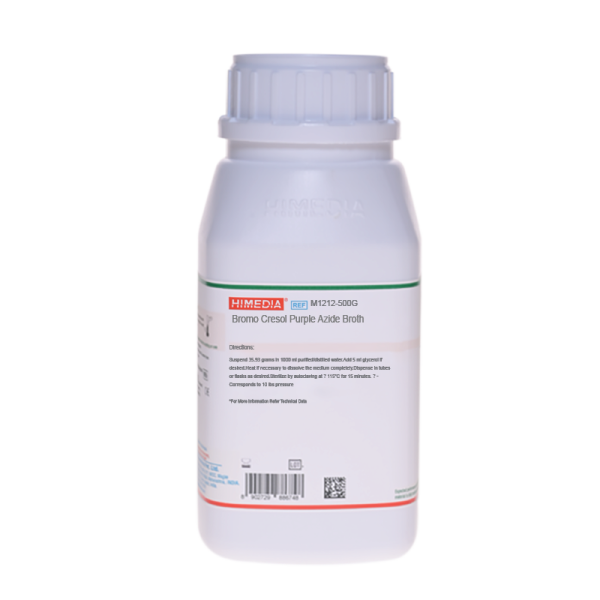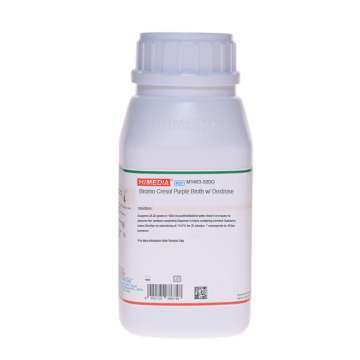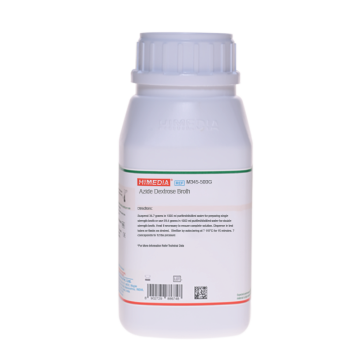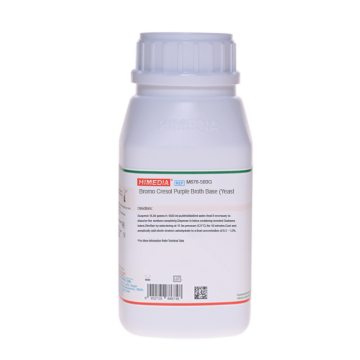 Your enquiry has been submitted
Your enquiry has been submitted
Bromo Cresol Purple Azide Broth
Intended use
Recommended for the confirmation of the presence of faecal Streptococci in water and wastewater.
Composition**
| Ingredients | Gms / Litre |
|---|---|
| Tryptone | 10.000 |
| Yeast extract | 10.000 |
| D-Glucose | 5.000 |
| Sodium chloride | 5.000 |
| Dipotassium hydrogen phosphate | 2.700 |
| Potassium dihydrogen phosphate | 2.700 |
| Sodium azide | 0.500 |
| Bromocresol purple | 0.032 |
Final pH (at 25°C): 7.0±0.2
**Formula adjusted, standardized to suit performance parameters
Directions
Suspend 35.93 grams in 1000 ml purified / distilled water. Add 5 ml glycerol if desired. Heat, if necessary to dissolve the medium completely. Dispense into test tubes or flasks as desired. Sterilize by autoclaving at 10 lbs pressure (115°C) for 15 minutes.
Principle And Interpretation
Enterococci are widely distributed and occur in different habitats. The Enterococci portion of the faecal Streptococcus group is a valuable bacterial indicator for determining the extent of faecal contamination of recreational surface waters. Studies indicate that swimming associated gastroenteritis is related directly to the quality of bathing water and that enterococci are the most efficient bacterial indicators of water quality (2, 3). Bromo Cresol Purple Azide Broth formulated as per Hajna & Perry (4) is used for the confirmation of the presence of faecal streptococci in water and wastewater. This medium is used for testing water samples, after preliminary testing of water samples in Azide Dextrose broth (M345). Bromo Cresol Purple Azide Broth is recommended by APHA for enumerating faecal streptococci by the MPN technique (5).
Bromo Cresol Purple Azide Broth has dextrose (D-glucose) as the fermentable carbon source and bromocresol purple as an indicator. The colour change of the medium from purple to yellow indicates fermentation of dextrose (D-glucose) and subsequent acid production. According to Hajna, enterococcal dextrose fermentation is improved by the addition of glycerol (4). Tryptone and yeast extract supply nitrogenous compounds, sulphur, and long chain amino acids and trace ingredients. Sodium chloride maintains osmotic balance of the medium. Sodium azide inhibits the entire bacterial flora including those species that may have grown in the preliminary test media. Colour change to yellow with turbidity indicates and confirms the growth of Enterococci.
Type of specimen
Water samples
Specimen Collection and Handling:
For water samples, follow appropriate techniques for sample collection, processing as per guidelines and local standards.(1) After use, contaminated materials must be sterilized by autoclaving before discarding.
Warning and Precautions :
Read the label before opening the container. Wear protective gloves/protective clothing/eye protection/ face protection. Follow good microbiological lab practices while handling specimens and culture. Standard precautions as per established guidelines should be followed while handling specimens. Safety guidelines may be referred in individual safety data sheets.
Limitations :
- Due to nutritional variations some strains may show poor growth.
Performance and Evaluation
Performance of the medium is expected when used as per the direction on the label within the expiry period when stored at recommended temperature.
Quality Control
Appearance Light yellow to beige homogeneous free flowing powder
Colour and Clarity of prepared medium Purple coloured, clear solution without any precipitate
Reaction Reaction of 3.6% w/v aqueous solution at 25°C. pH: 7.0±0.2
pH 6.80-7.20
Cultural Response
Cultural characteristics observed after an incubation at 35-37°C for 24-48 hours.
| Organism | Inoculum (CFU) | Growth | Acid |
|---|---|---|---|
| Enterococcus faecalis ATCC 29212 (00087*) | 50-100 | good-luxuriant | positive reaction, yellow colour |
| Escherichia coli ATCC 25922 (00013*) | >=104 | inhibited | |
| Pseudomonas aeruginosa ATCC 27853 (00025*) | >=104 | inhibited | |
| Streptococcus agalactiae ATCC 13813 | 50-100 | none-poor | negative reaction, no colour change |
| Streptococcus pyogenes ATCC 19615 | 50-100 | none-poor | negative reaction, no colour change |
Key: *Corresponding WDCM numbers.
Storage and Shelf Life
Store between 10-30°C in a tightly closed container and the prepared medium at 20-30°C. Use before expiry date on the label. On opening, product should be properly stored dry, after tightly capping the bottle in order to prevent lump formation due to the hygroscopic nature of the product. Improper storage of the product may lead to lump formation. Store in dry ventilated area protected from extremes of temperature and sources of ignition Seal the container tightly after use. Product performance is best if used within stated expiry period.
Disposal
User must ensure safe disposal by autoclaving and/or incineration of used or unusable preparations of this product. Follow established laboratory procedures in disposing of infectious materials and material that comes into contact with sample must be decontaminated and disposed of in accordance with current laboratory techniques (6,7).
Reference
- Baird R.B., Eaton A.D., and Rice E.W., (Eds.), 2015, Standard Methods for the Examination of Water and Wastewater, 23rd ed., APHA, Washington, D.C.
- Cabelli V. J., 1983, EPA-600/1-80-031, U. S. Environmental Protection Agency, Cincinnati, Ohio.
- Dufour A. P., 1984, EPA-600/1-84-004, U. S. Environmental Protection Agency, Cincinnati, Ohio.
- Hajna A.A. and Perry C.A., 1943, Am. J. Publ. Health, 33:550.
- Hajna A.A., 1951, Public Health Lab., 9:80-81.
- Isenberg, H.D. Clinical Microbiology Procedures Handbook 2nd Edition.
- Jorgensen, J.H., Pfaller, M.A., Carroll, K.C., Funke, G., Landry, M.L., Richter, S.S and Warnock., D.W. (2015) Manual of Clinical Microbiology, 11th Edition. Vol. 1.
| Product Name | Bromo Cresol Purple Azide Broth |
|---|---|
| SKU | M1212 |
| Product Type | Regular |
| Physical Form | Powder |
| Origin | Animal |
| Packaging type | HDPE |
| References | 1. Cabelli V. J., 1983, EPA-600/1-80-031, U. S. Environmental Protection Agency, Cincinnati, Ohio. |
| Customized Product Available | No |











